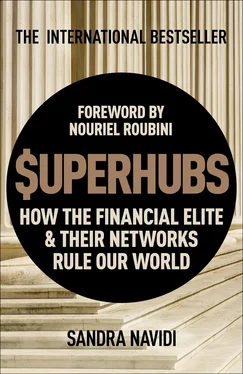Sandra Navidi - SuperHubs - How the Financial Elite and Their Networks Rule our World
Здесь есть возможность читать онлайн «Sandra Navidi - SuperHubs - How the Financial Elite and Their Networks Rule our World» весь текст электронной книги совершенно бесплатно (целиком полную версию без сокращений). В некоторых случаях можно слушать аудио, скачать через торрент в формате fb2 и присутствует краткое содержание. Год выпуска: 2017, Издательство: Hodder & Stoughton, Жанр: Старинная литература, на английском языке. Описание произведения, (предисловие) а так же отзывы посетителей доступны на портале библиотеки ЛибКат.
- Название:SuperHubs: How the Financial Elite and Their Networks Rule our World
- Автор:
- Издательство:Hodder & Stoughton
- Жанр:
- Год:2017
- ISBN:нет данных
- Рейтинг книги:4 / 5. Голосов: 1
-
Избранное:Добавить в избранное
- Отзывы:
-
Ваша оценка:
- 80
- 1
- 2
- 3
- 4
- 5
SuperHubs: How the Financial Elite and Their Networks Rule our World: краткое содержание, описание и аннотация
Предлагаем к чтению аннотацию, описание, краткое содержание или предисловие (зависит от того, что написал сам автор книги «SuperHubs: How the Financial Elite and Their Networks Rule our World»). Если вы не нашли необходимую информацию о книге — напишите в комментариях, мы постараемся отыскать её.
SuperHubs: How the Financial Elite and Their Networks Rule our World — читать онлайн бесплатно полную книгу (весь текст) целиком
Ниже представлен текст книги, разбитый по страницам. Система сохранения места последней прочитанной страницы, позволяет с удобством читать онлайн бесплатно книгу «SuperHubs: How the Financial Elite and Their Networks Rule our World», без необходимости каждый раз заново искать на чём Вы остановились. Поставьте закладку, и сможете в любой момент перейти на страницу, на которой закончили чтение.
Интервал:
Закладка:
Yet secrecy evokes suspicion, and some outsiders believe Bilderberg to be a global corporate-controlled shadow government, bent on engineering the fate of humanity. While this is a bit far-fetched considering the varying participants and interests, the direct interaction of such powerful people behind closed doors without any involvement of civil society does pose a problem, because they are privy to the most valuable opportunities and can align their interests without any accountability. However, the most dangerous collusions typically happen in plain sight, especially in the form of lobbying. After all, even if they had nefarious intentions, there is no need for Bilderberg participants to travel to faraway locations when they could communicate in private over the phone. Since they all know each other, they can have the same meetings and conversations in their favorite three-star restaurants, on their yachts, and on weekend retreats, without global media scrutiny. Possibly the greatest attraction for participants is the public manifestation of their elite status.
STEALTH POWER: FAMILY OFFICE GATHERINGS
The grounds of the Swiss Re Centre in Rüschlikon, Switzerland, are nothing short of spectacular. They comprise an expansive compound with beautifully designed gardens overlooking Lake Zürich and the Alps. The modernist conference center’s clean architecture is the perfect backdrop for its eclectic interior design and vast art collection. Across the garden, an allée of lime trees leads up to the neobaroque Bodmer mansion, which was built by a Swiss industrialist in the 1920s.
Such was the scene of one of the family office gatherings that I regularly attended. Bodyguards clad in black pants and turtlenecks protected the family principals and their top executives, who represented a net worth of about $150 billion under one roof. Throughout my career, I had only dealt with institutional investors, but after starting my own company, I stumbled into the private wealth space. Because I knew many ultra-high-net-worth individuals globally, the family office of an IT billionaire asked me to assist in building a global nonprofit platform for family offices, where they could meet to exchange views and cooperate without the involvement of financial intermediaries, such as bankers or other service providers like attorneys and tax advisers. Such gatherings are among the most exclusive and private, because these families and their representatives only open their ranks if you are one of them.
Family offices are the investment management companies of wealthy families. Banks, financial firms, and multifamily offices typically manage the assets of families worth up to $500 million. For families worth more than $500 million in liquid assets, having their own investment firms is expedient, because it affords them control, privacy, and cost efficiencies. The concept of a family office has evolved over a long time. Business tycoon John D. Rockefeller set up his family office in the nineteenth century. Often families have come into great wealth by building enormously successful companies, sometimes over the span of several generations. Among them are old industrial dynasties, nouveau industrialists, or tech billionaires. Some families consist of fewer than a dozen members, while others encompass hundreds. The priority of family offices is wealth preservation.
According to a saying, a fortune lasts for three generations: The first one makes it, the second one lives on it, and the third one squanders it. Most family principals are not financial titans in the classic sense because they have not made their money in the financial services industry. However, the wealth accumulated from building large, successful companies gives them enormous economic power. With their investments, they actively influence the international economic and financial landscape. In 2016 there were 1,810 billionaires in the world—with an aggregate net worth of $6.5 trillion—540 of which are in the U.S., among them financiers such as George Soros, Stanley Druckenmiller, Steve Cohen, Steve Schwarzman, and Leon Black.6 Many of them have their own family offices. Family office principals, who typically are hardworking and well grounded, above all treasure privacy. They institute high barriers to entry, often employing gatekeepers to filter and vet requests, because their riches make them perpetual targets for people who want something from them.
As important job creators, taxpayers, and philanthropic supporters, family offices are powerful and influential forces in their communities. Whenever we invited public officials to a family office gathering, they would happily attend.
A family office platform facilitates networking so that families can benefit from each other’s experiences, coinvest, and leverage buying power. A Saudi Arabian family in the oil business might share insights on commodity prices, while a German industrialist provides intelligence on potential acquisition targets in the highly coveted German Mittelstand companies. A British billionaire can invite other families to participate in his socially responsible infrastructure investments, while an Indian entrepreneur might look for coinvestors in the telecom sector. The point is to obtain original information directly from the source rather than secondary, diluted information from a third party with incongruent interests. Family offices are another example of how people with similar characteristics flock to each other and maximize their power. They have better access to opportunities and the means to capitalize on them, which self-perpetuates their network power.
FEEDING OFF POWER: POWER LUNCHES
In addition to structured events such as Davos and the IMF meetings, most superhubs regularly maintain their personal networks at power-player restaurants, one of which until mid-2016 had been the überexclusive Four Seasons restaurant in New York. It was located in the Seagram Building on Park Avenue in Midtown Manhattan, a building widely regarded as a modernist architectural masterpiece. The restaurant consisted of two dining rooms—the Pool Room and the Grill Room—which were connected by a corridor featuring the largest Picasso canvas in the United States, a stage curtain from the 1919 French production of the ballet Le Tricorne. The magnificent Pool Room was centered around a white Carrara marble pool and framed by large seasonal plants: palm trees in the summer, Japanese maples in the fall, birches in the winter, and blossoming cherry trees in spring. Both rooms were decorated with bronze-colored aluminum mesh chain curtains, which absorbed the subtle lighting as soaring twenty-foot-high ceilings gave the prolific modernist artworks adequate breathing room.
For lunch there was only one option: the Grill Room. In contrast to many other restaurants in New York City, where carrying on a conversation is a challenge due to the high decibel level, the dignified Grill Room’s spaciousness seemed to absorb noise and ensure discreetness. The Four Seasons’ history and character were palpable, and it commanded a loyal following among the world’s elite. Henry Kissinger was a regular for decades, as were Steve Schwarzman, Pete Peterson, Larry Fink, and Paul Volcker, among many others. Virtually every tycoon mentioned in this book passed through its doors. For me, every luncheon was a memorable experience—not only because I always got Kissinger’s table in his absence—but because the surreal power concentration always seemed to trigger something meaningful to happen: an unexpected encounter, an introduction, an invitation, an opportunity, the beginning of a dialogue, or the resuscitation of a dormant connection.
Unfortunately, the Four Seasons eventually became the stage of its own demise. The historic and pedigreed restaurant saw its final act, its Picasso curtain removed and the lights turned off. The Seagram Building’s German-born owner and New York social scene staple, Aby Rosen, put the gun to Four Seasons tenant Julian Niccolini’s head to either pay a significantly higher lease or move out. As if this wasn’t bad enough, the culinary temple then became the scene of an unappetizing scandal in which Niccolini was accused of sexual assault. In a deal with prosecutors, he pleaded guilty to misdemeanor assault to resolve the allegation.7 Rosen will establish a new, more modern place at the old locale, and Niccolini will open his new Four Seasons on Park Avenue a few blocks down, with many of his loyal patrons likely in tow. It may be the end of the Four Seasons as we now know it, but it certainly won’t be the end of the power lunch.
Читать дальшеИнтервал:
Закладка:
Похожие книги на «SuperHubs: How the Financial Elite and Their Networks Rule our World»
Представляем Вашему вниманию похожие книги на «SuperHubs: How the Financial Elite and Their Networks Rule our World» списком для выбора. Мы отобрали схожую по названию и смыслу литературу в надежде предоставить читателям больше вариантов отыскать новые, интересные, ещё непрочитанные произведения.
Обсуждение, отзывы о книге «SuperHubs: How the Financial Elite and Their Networks Rule our World» и просто собственные мнения читателей. Оставьте ваши комментарии, напишите, что Вы думаете о произведении, его смысле или главных героях. Укажите что конкретно понравилось, а что нет, и почему Вы так считаете.












